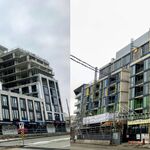nfitz
Superstar
Something like that - and the London Underground staff standing on the fare lines, do have that role. Mostly they are watching for issues, but they are talking to people to. Answering questions. Helping get large bags through the fare lines. Presumably assisting with the fare vending machines too - I didn't see that, but similar staff on PATH helped me navigate their rather confusing system, that let's you buy completely different cards.weret the former fare collectors supposed to be repurposed as ambassadors and assistants?
That's good to hear. Perhaps just teething problems. Do they really try to use the gates bi-directionally in Boston at the same time? Reading Boston's info - I can't see any info on how one exits through the fare gates? Do they not use the gates, or are those Charlies just stuck on the system forever? (edit - the picture below suggests they are used for exit too).The fare gates are off-the-shelf for the most part, made by Scheidt & Bachmann. Other cities - Boston, for example - use very similar fare gates from the same company without all these problems.
Hmm, looking at photos, the Boston gates don't look the same. The gates are a different shape, and look more sturdy.
Also, Boston is much quieter system. There's only 3 stations with more than 20,000 passengers a day, and the highest is about 25,000 according to https://www.boston.com/news/local-news/2015/08/25/these-are-the-busiest-t-stops
Compare to TTC - Wellesley is 23,000 - and it's the quiet downtown stop no one uses! We've got over 35 stations higher than 20,000 (not including transfer stations) with some over 100,000 (Bloor-Yonge is about 400,000, St. George is about 260,000, Kennedy is over 100,000, Sheppard-Yonge is 120,000).
Even under-used Don Mills on the Sheppard line is almost 34,000 - far higher than any Boston station.
So why does Boston seem to have sturdier looking gates, for far less traffic? Did we buy the wrong ones?
Attachments
Last edited:






